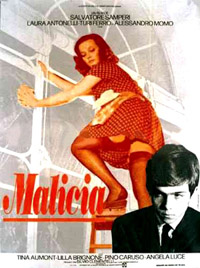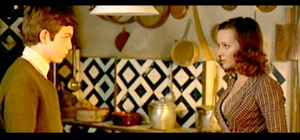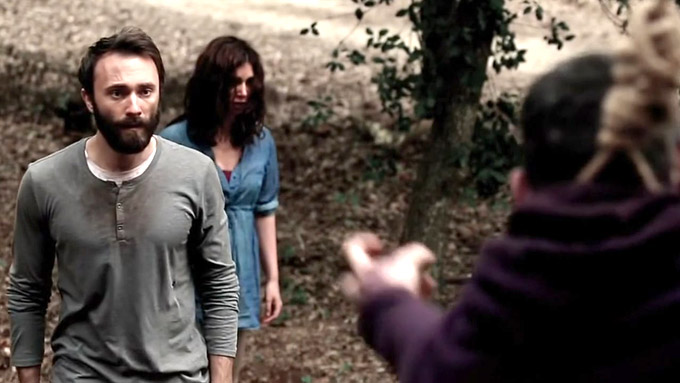
Aka Malicious
1972
Original running time: 99 mins
Italy
A Clesi production
Distributed by Cineriz
Director: Salvatore Samperi
Story: Salvatore Samperi
Screenplay: Ottavio Jemma, Sandro Parenzo, Salvatore Samperi
Cinematogrpahy: Vittorio Storaro
Music: Fred Bongusto
Editor: Sergio Montanari
Cast: Laura Antonelli (Angela), Turi Ferro (Ignazio), Alessandro Momo (Nino), Tina Aumont (Luciana), Lilla Brignone (Granma), Pino Caruso (Don Cirillo), Angela Luce (Widow Corallo), Stefano Amato (Porcello), Gianluigi Chirizzi (Nuccio), Grazia Di Marzà (Adelina), Massimiliano Filoni (Enzio)
Salvatore Samperi, who died in March this year, was another of those directors with a name that’s very familiar to me even though I haven’t actually seen any of his films. Born in Padua in 1944, he was part of a group of filmmakers to emerge from Venice in the late 1960s, others including Tinto Brass and Aldo Lado. Like Brass, particularly, his films tend to mix up eroticism with a rather skeptical view of Italian manners, and they also manage to be surprisingly elegant given their puckish, saucy storylines.
Samperi made his debut with Grazie zia (68), which was swiftly followed by Cuore di mamma (69) and Uccidete il vitello grasso e arrostitelo (70). Despite them being moderately popular, he reportedly gained a reputation amongst producers as someone who had problems finishing projects, and it was really with Malizia, which was hugely successful on its initial Italian release (making 2,172,000,000 lire) that he cemented his reputation. Curiously, many of his films from this period are based around a similar narrative, in which an adolescent boy or young man is traumatised in some way and develops an unhealthy sexual obsession with an attractive older woman. It’s a model which Malizia follows almost to the letter.

When his wife dies, the much respected and wealthy shopkeeper Ignazio La Brocca (Turi Ferro) is left a widower. What’s more he’s left with three sons to look after: eighteen year old Antonio (Gianluigi Chirizzi), fourteen year old Nino (Alessandro Momo) and nine year old Enzino (Massimiliano Filoni). To help him out, he takes on a new housekeeper, Angela (Laura Antonelli), who proves not only to be more than capable of looking after them all, but also rather hot to boot.
Before long, Ignazio is stealing glances at her bottom at every opportunity, and both Antonio and Nino are going out of their horny, adolescent minds with lust. Nino even begins telling his dumb-ass friends that he’s actually sleeping with her, while the disrespectful Antonio unsuccessfully tries to seduce her. Things take a turn for the worse, though, when Nino discovers that his father has proposed to her, at which point he starts threatening to turn everyone – and most particularly Enzino – against her unless she does exactly as he tells her. His demands become increasingly sexual and vindictive, until Angela is left with no option but to turn the tables on him.
This is another in a trend in Italian films from the early seventies to feature a sexy young woman arriving in the household of a supposedly bourgeois family and arousing all sorts of uncivilised passions (see also La nipote etc etc). It’s a kind of erotic melodrama with comic moments, but all done in a very artful, elegant fashion, with few of the more exploitative elements that characterised these kinds of productions. It’s beautifully shot by Vittorio Storaro, although you’d be hard pressed to tell this from the appallingly pan and scanned English language versions currently available, and there’s also a great soundtrack by Fred Bongusto, even if it occasionally breaks out into a kind of cheerily demented noodling that’s quite impressively inappropriate for what’s happening on screen.

Although the story has a darker aspect – Nino is an ‘orrible little creep who frankly needs a good slap around the chops – it’s a generally upbeat production, and the more sordid and cruel aspects are rather underplayed. To keep the intellectuals happy there are a few comments about class – with the poor Angela being treated as a general dogsbody by the La Brocca’s – and also about Italian social manners of the time (including an amusingly subverted funeral and wedding sequence). But it doesn’t feel particularly substantial, and although it won a couple of awards it’s hard to see quite why, as there were far, far better films made by Italian directors that year. It’s decently put together, undoubtedly, but when it comes down to it it’s all actually a little bit silly.
But it wasn’t just the critics who approved, and Malizia was a hugely popular film throughout Europe. Perhaps this was something to do with the fact that it was seen as rather a controversial production, showing both a teenage boy both sexually abusing an older woman and a being cajoled, not unwillingly, into having sex. Or maybe it had more to do with the fact that much of the publicity featured Laura Antonelli in a state of undress, which was actually rather misleading because until the climax she remains fully clothed. Whatever the case, this was the film that made her a star, and she deserves it, putting in a warm, persuasive performance that’s a class above that of the usual euro-sexpots who populated these kinds of films. She’d work with Samperi three more times, on Peccato veniale (74), Casta e pura (81) and finally on a little seen sequel, Malizia 2000 (91), which also featured Turi Ferro.

Great film loved seeing it, as in the many times I have at cinemas and on Video now DVD yes the publicity was misleading but dose not change the fact she is and was a very beautiful women, there is a very nice little photo gallery of her at http://www.premiererow.com/2010/09/laura-antonelli-name-laura-antonelli.html carry’s lots of stills from the film. would just have to say one thing I do not see it as him sexually abusing as she could of stopped him but did not.is just a great film sadly 2000 did not gt the same attention from the press or the public.
I really enjoyed the film, and it was nice seeing Angela turning the tables on him.
@Alessandro:
Don’t be ignorant. Just because she didn’t stop him doesn’t mean he wasn’t sexually harassing her. Women who have been sexually harassed usually don’t stop or report their harasser due to fear, shame, or even embarrassment. Heck, some don’t even report harassment because they’re always get shamed on.
I love Alessandro momo he was sooooooooooo hot when he was younger to sad he died bohoooooooooo!
where can i watch this movie in english or with english subtitles?
“It’s beautifully shot by Vittorio Storaro, although you’d be hard pressed to tell this from the appallingly pan and scanned English language versions currently available…”.
Do you recommend a particular version of this film to fully enjoy Storaro’s artistry?
I think the facial expressions of Ms Antonelli in the scenes with Alessandro Momo are priceless and convey a deeper side to the character of Angela. Wonderful.
Nice review